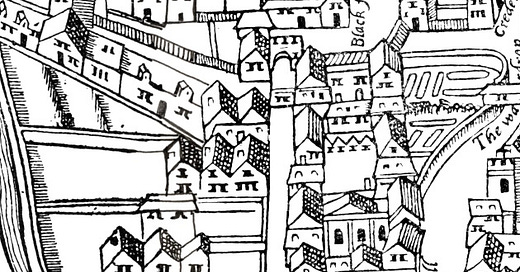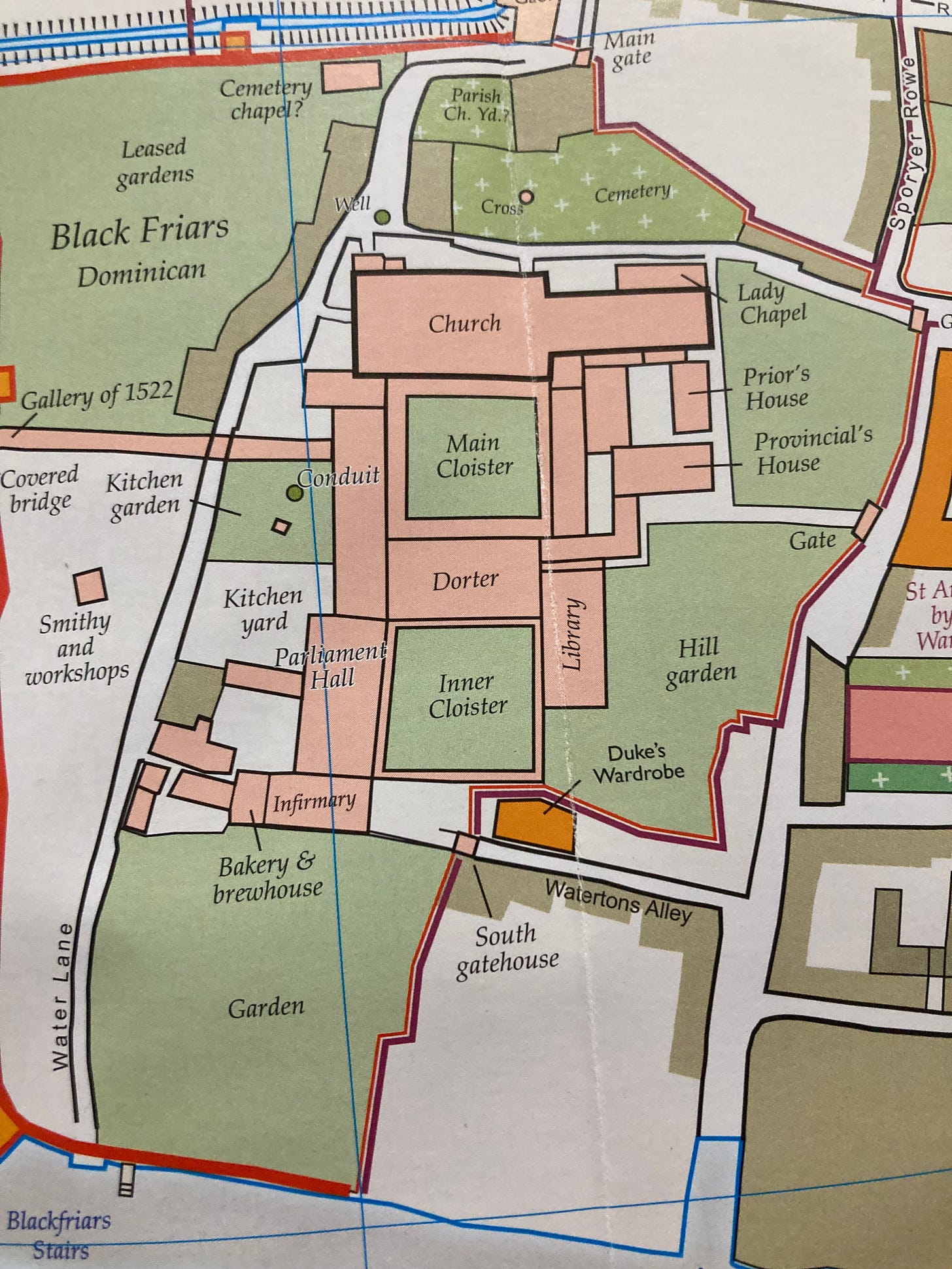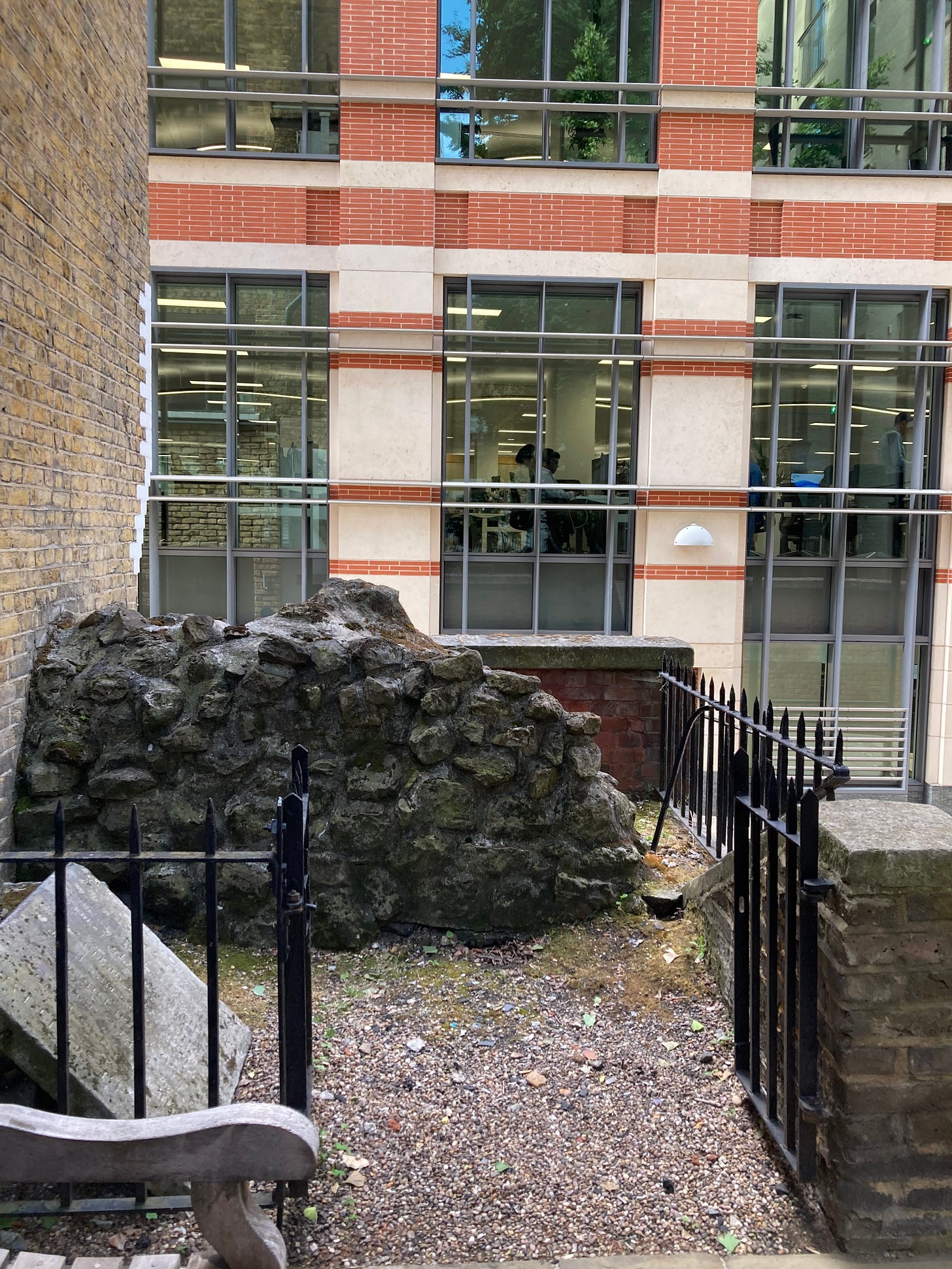The above map shows “Church Entry” as it was roughly 25 years after the dissolution of the monasteries (the long street running south to the Thames in the center of the map). Below, in gloriously modern detail, comes from roughly 15 years before the dissolution. The bit at the top of the Church which looks like a very short road is the vantage point from which I photographed the street in my previous screed on this topic:
It is difficult to imagine any earthquake so eradicating anywhere so entirely as did Henry VIII and his minions (St. Southwell’s grandfather and his brother among those right in the thick of it with their snouts in the trough of despoilation and death). Even the 1940s “archaeology from the skies” movement has not turned up any physical remains of the Blackfriars which remain in situ. This, and only this, which may or may not be from the Priory, might possibly be medieval, is all I can find:
This piece of wall is presently situated, as far as I can estimate, somewhere to the right of the “Main Cloister” in the above map.
That is not, of course, to downplay earthquakes. It has rightly, and wisely, been pointed out that earthquakes carried more significance in the Middle Ages than today. Along with the death, destruction and horrendous clamor came a message from God from which arises the pointing of fingers.
Let us first consider the message itself before pointing any fingers. I shall start from the premise that the Triune God speaks to mankind via seismic activity. Only for real: we Papists are presently required to believe, and do believe, in the most extraordinary stuff. You know, all that things we are supposed to feel embarrassed about in these “modern” days (which have been going on for some three centuries now). Angels. Demons. The Devil. Possession. Transubstantiation. The Virgin Mary coming to visit Portugal. Earthquakes as “divine discourse” ought not present too much difficulty. A real message from the real God.
Without presuming to have knowledge of God’s will at any time at all, never mind in May 1382, even a cursory review of the relevant material and facts makes it plain that God does not express happiness, joy, mercy, forgiveness or anything good at all when He speaks earthquake. As with the Lord, so with his Mother. It would not be outside the realm of imaginings that perhaps the Blessed Mother might make a rather dramatic, and entirely beautiful, entrance via earthquake: the earth opens, up pops Mary, flowers burst forth, and so on. It’s simply not the done thing with God or among his circle.
No, the Lord only expresses displeasure and upset via earthquakes. Before considering at whom this displeasure may have been directed it will be helpful to consider just how upset God was on 21 May 1382. For that we resort to the Jesuit Science – seismology (because the Jesuits didn’t just invent the umbrella). It turns out, the answer is VERY DISPLEASED:
Note the yellow circle right there in London where the synod happened. 5 to 5.5 is no laughing matter. Canterbury got mauled, being closer to the epicentre. Red circle. 7+. Dommages Prononcéss indeed. Contemporary sources contain records of the money required to effect repairs. Some places in Canterbury simply stayed ruined. The Augustinian Priory, if memory over 27 years serves, remains a ruin to this day.
As concerns finger pointing, John Foxe (inimitable scourge of Popery) had his mind firmly made up: God was angry at the Papists. A predictable, but not prima facie unreasonable, conclusion from the Master Foxe as seen previously in this screed. The Papists, such as we have heard from them thus far, at first blush thought they ought to pause and consider what the Almighty may wish to communicate to his children. The coincidence would not have been lost on them that the children happened to be playing with the Church at the time and might break it. The Archbishop took the message as an exhortation to smite heresy and root out the heretics. Again, a predictable but not unreasonable approach to the seismic narrative. We have the same answer from both ends: God was angry with the other guy.
So who was right? What if God was unhappy about something or someone else? Who was really to blame for the 21 May 1382 earthquake?
After a mere DCXLI years and LII days, dear readers, these questions will get answered. On the next occasion, the first and obvious suspect, the wily and pernicious heresiarch John Wycliffe. Until then, I remain as always highly partial to a bit of the old Popery as well as
Your devoted wretch,
Peregrinus









I absolutely love this, Peregrinus!
“You know, all that things we are supposed to feel embarrassed about in these “modern” days (which have been going on for some three centuries now). Angels. Demons. The Devil. Possession. Transubstantiation. The Virgin Mary coming to visit Portugal. Earthquakes as “divine discourse” ought not present too much difficulty. A real message from the real God.”
If the Lord of all ever wills that we should meet in person, I’ve no doubt you, my husband, and I shall become fast and lasting friends.